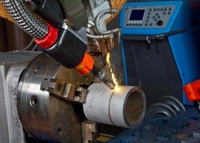GE Unveils Ultra Powerful High-Tech Laser Welding System
NISKAYUNA, NY—April 15, 2011: GE scientists and engineers at the company’s Global Research headquarters in Niskayuna, NY today unveiled a high-power hybrid laser arc welding (HLAW) system that will revolutionize how industrial products are manufactured in the future. For more information and to see a video demonstrating the laser welding system, check out Edison’s Desk at High Tech Laser Welding System.
“Manufacturing is becoming increasingly high-tech, with the introduction of advanced tools and processes that can make products better, faster and at substantially lower costs”
At 20 kW, GE’s system is one of the largest HLAW facilities in North America. It wields enough power to weld steels nearly one-inch thick in a single pass versus the up to a half dozen passes required with current welding technologies. Utilizing HLAW will dramatically increase the speed at which industrial products are manufactured in the future. For example, going from conventional welding processes to HLAW to weld the aircraft carrier USS Saratoga could have saved nearly 800 tons of weld metal (equal to the weight of more than 600 compact cars) and reduced the welding time by 80%. GE is exploring this technology for application across its infrastructure manufacturing operations, including the oil and gas, power generation, aviation and rail industries.
“;Manufacturing is becoming increasingly high-tech, with the introduction of advanced tools and processes that can make products better, faster and at substantially lower costs,” said Luana Iorio, Manufacturing Technologies Leader at GE Global Research. “;HLAW technology is part of a broad portfolio of next generation manufacturing tools GE is developing to improve our manufacturing competitiveness and take product performance to the next level.”
Welding is fundamental to the manufacture of virtually any product made with metal components. It also is one of the most time-consuming elements of a manufacturing process. Furthermore, welding has traditionally taken place within a centralized manufacturing operation, which often is a great distance from a finished product’s final destination. This makes shipping more complex and costly. New, breakthrough-manufacturing tools like GE’s HLAW system will eventually break the mold, enabling parts to be welded in just of a fraction of the time it takes today with greater consistency.
Iorio said, “;The portability of this new-high power laser platform will enable us to think very differently about how parts are welded. For example, we can now think about welding parts onsite where a product will be located, as opposed to the traditional manufacturing floor. This also will simplify and reduce time in the shipping process.”
How it works
GE’s hybrid laser arc welding (HLAW) process uses a combination of laser welding and arc welding. With high-power fiber lasers, one is able to weld steels greater than 0.5” thick in a single pass at speeds greater than 6 ft/min. The result is a higher quality weld compared to traditional multi-pass welding approaches. To develop this technology, GE has leveraged decades of expertise in electrical power and laser technology. GE’s history in laser technology spans five decades , and it has been extensively applied for manufacturing applications.
Over the years, GE has pioneered the use of lasers in manufacturing applications ranging from laser hole drilling in aircraft turbine blades to the first use of lasers for surface treatment of fan blades for better durability. Lasers are also used to weld filaments for lighting products, lamination spacers for generators, and components for X-ray tubes. In recent years, GE has developed new applications of the laser that include the measurement of precision parts in production applications, the repair of power generation parts and the processing of solar panel materials.
The development of the HLAW system underscores GE’s commitment to infuse advanced technologies into its manufacturing processes. Global Research is investing in a diverse array of more than 100 manufacturing and inspection technology programs and inventing new ways to make products. In October 2009, GE opened the Advanced Manufacturing and Software Technology Center in Michigan that is dedicated to accelerating the development of next generation manufacturing technologies for GE’s industrial products. Together with GE’s Global Research network, the new Center is a vital part in GE’s strategy to successfully transition promising new technologies and processes from the lab to the manufacturing floor. These breakthroughs will redefine how products are made in the future.
About GE Global Research
GE Global Research is the hub of technology development for all of GE's businesses. Our scientists and engineers redefine what’s possible, drive growth for our businesses and find answers to some of the world’s toughest problems.
We innovate 24 hours a day, with sites in Niskayuna, New York; Bangalore, India; Shanghai, China; Munich, Germany; and fifth global research facility to open in Rio de Janeiro, Brazil in 2012. Visit GE Global Research on the web at GE Research . Connect with our technologists at Twitter .



